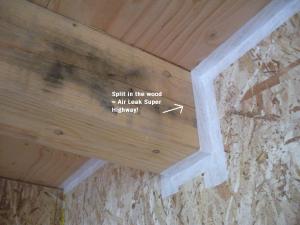 Announcing the Mini-B Passive House! Mini-B stands for Mini Bungalow and was designed by Joe Giampietro, a fellow Certified Passive House Consultant. Joe is an Architect and he took on an impressive Passive House challenge – a small structure. Passive House uses a lot of modeling, some of which compares the volume of the house to the footprint area it takes up to determine energy usage. The smaller the structure, the tougher the challenge. I am happy to report that the Mini-B has passed the blower door test with a .58ACH @ 50 Pascal and has been pre-certified by Passive House US.
Announcing the Mini-B Passive House! Mini-B stands for Mini Bungalow and was designed by Joe Giampietro, a fellow Certified Passive House Consultant. Joe is an Architect and he took on an impressive Passive House challenge – a small structure. Passive House uses a lot of modeling, some of which compares the volume of the house to the footprint area it takes up to determine energy usage. The smaller the structure, the tougher the challenge. I am happy to report that the Mini-B has passed the blower door test with a .58ACH @ 50 Pascal and has been pre-certified by Passive House US.
Why such a small structure you may ask. Joe planned the Mini-B to meet the Detached Accessory Dwelling Unit requirements that the city of Seattle has developed for placing an accessory dwelling on properties within the city. More than just a fancy backyard office (though it certainly could work for that purpose!) the Mini-B is designed to be lived in. What used to be called a “Mother-in-law” cottage, this Passive House could be used as a rental, guest cottage, office, man-cave, home away from home but not too far away from home, or just about anything you could put your mind to.
The Mini-B is plumbed to have a shower and a kitchen. A small living area on the main floor is supplemented with 2 small loft areas above. Obviously the intent is for a limited amount of people, but what a great way to provide additional income for someone, or have family close by but not underfoot.
Designed with all the Passive House features, this low energy, high comfort structure will perform to Passive House standards in a sunny southern location as designed, but could be designed to fit the solar requirements of other locations. Obviously a very shaded lot could exceed the Passive House limits for such a small structure, but the modeling before hand would assist with making it the most energy-efficient structure possible for that location. Joe said the Mini-B could even be designed to work over a garage, though existing garages would need to be examined to see if they could support an addition. A likely change would be to build a new garage under the Mini-B in those instances where the existing structure was not strong enough.
Joe is so passionate about this project that someone involved with it has even referred to the house as the Passion House because of the zeal and interest it has generated. Joe was quick to point out it was not a “Love Shack”, but… 😉 So… where can you get more information and see more pictures of this Passive House marvel? At my newest blog! So far I just have Joe’s project listed and a link back to here for Dan’s project. I will be updating the blog with a project page for Dan’s project real soon now. If any other Passive House projects would like to be included on the new blog, you can contact me for additional information (LindaWhaley@ExistingResources.com ).
Click on the link to see the new blog, check out the Mini-B, and sign up to receive updates as new projects are entered. I won’t be following projects on that blog like I have Dan’s, but I will have plenty of “Passive House nerd info” available. Please give me feedback on additional information you would like to see there!
Visit the new blog! http://passivehouseprojects.US/
-Linda
Read More






Recent Comments